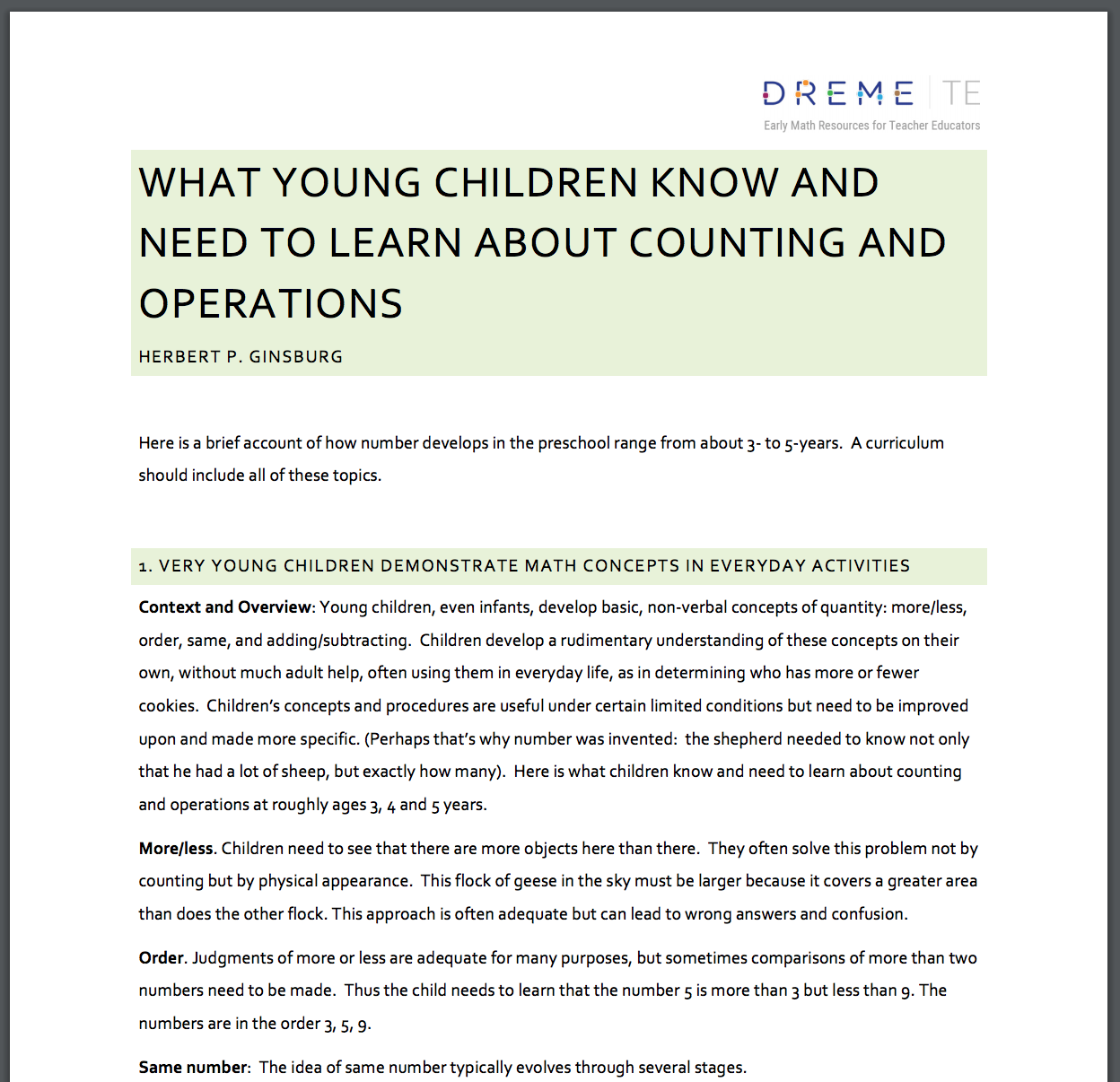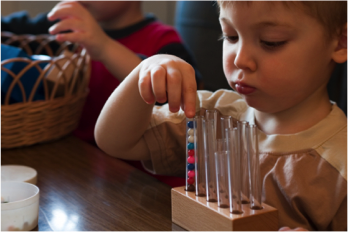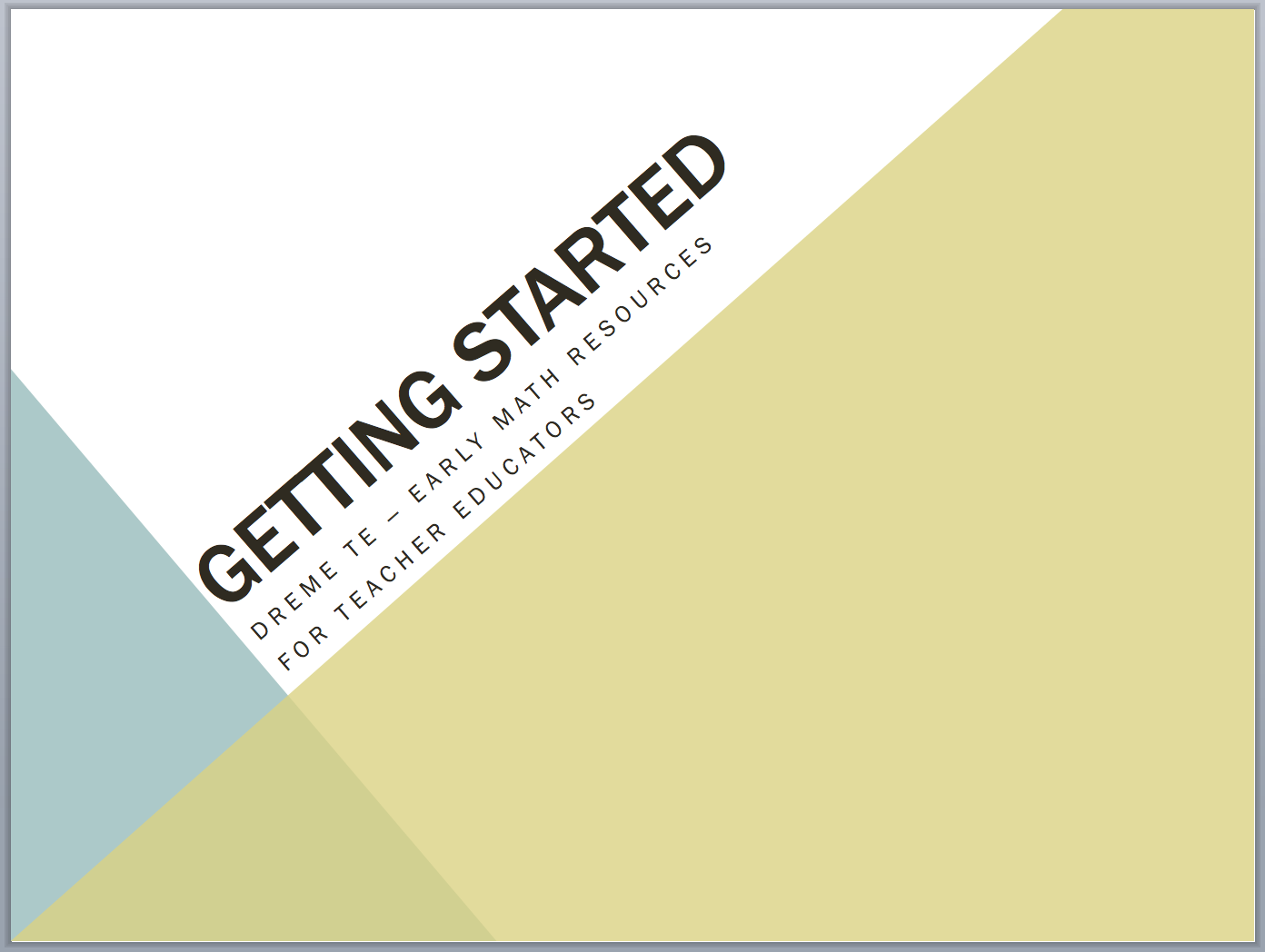Children have intuitive ideas about operating on number from a very early age. This piece helps us begin to think about the ways in which young children encounter operations in their day-to-day interactions.
Luci’s mom enrolled her in an experiment at the nearby university that was designed to better understand six-month-old infants’ perceptions of number. During the experiment, Luci watched as an opaque screen was raised to hide a doll on a platform. As she continued to watch, she saw the researcher place a second doll behind the screen. When the researcher lowered the screen to reveal the dolls, there might be one, two, or three dolls on the platform (a hidden researcher was manipulating the number of dolls behind the screen). Luci looked longer when the screen was lowered and one or three dolls were exposed than when two dolls appeared. Researchers interpret the longer looking time as evidence that the result (e.g., one doll added to one doll, yet only one doll and not two revealed) was unexpected. The same thing occurred when two dolls were put behind the screen, followed by the visible removal of one doll; Luci looked longer when zero, two or three dolls were revealed (the “unexpected” result) compared to one doll (the “expected” result). It appears that very young children have expectations about what happens when you add things together or take things away.
 Quantity is important to children. More is an early vocabulary word and generally learned long before less or fewer (after all, who wants fewer Cheerios!). Children learn that adding to a set makes more, and taking away from a set makes less. Very young children notice when blocks are removed from their structures, and children avidly add to their collections of toys (more trucks!). Children don’t think of these as addition problems and solutions, but rather a way of solving issues that come up throughout their day (for instance, the problem of needing more Cheerios).
Quantity is important to children. More is an early vocabulary word and generally learned long before less or fewer (after all, who wants fewer Cheerios!). Children learn that adding to a set makes more, and taking away from a set makes less. Very young children notice when blocks are removed from their structures, and children avidly add to their collections of toys (more trucks!). Children don’t think of these as addition problems and solutions, but rather a way of solving issues that come up throughout their day (for instance, the problem of needing more Cheerios).
We can say that young children are naturally developing an everyday math that can serve as the foundation of math learning. This module focuses on children’s everyday operations on sets of objects. Children add things to sets and take things away. Children engage in joining, separating, comparing, and considering parts and wholes of sets. Eventually children start using counting words to help them in conducting operations and in examining and describing their results.
Young children encounter real-world addition and subtraction problems every day. The following scene illustrates a common sight in preschool classrooms.
Sanjay and Robbie have been playing with dinosaurs at the end of the day, and as Sanjay’s mom arrives, he pushes his pile of dinosaurs over towards Robbie’s collection, “You can have mine now. There’s five!” Teacher Melissa notices this transaction and uses this quiet time of day to encourage Robbie’s budding skills in addition. “Wow, Robbie! Sanjay sure gave you a lot of dinosaurs. How many do you think you have now?” Robbie starts to count, beginning with his collection and then continuing to Sanjay’s pile, moving them over to his collection one by one.
We frequently think of subtraction as being the exact opposite of addition, and may even think it is a more difficult operation than addition. But we need to remember that children don’t think of these problems as addition or subtraction (or as more difficult or easier!). They just think of them as problems that need to be solved:
Teacher Melissa: “Moses, I know you love building long bridges, but other children need to be able to use the cylinder blocks, too. You can have five. How many do you have now?”
Moses: [Counting his blocks] “One, two, three, four, five, six, seven. I have seven.”
Teacher Melissa: “How many do you need to put back in the container so that you have five?”
Moses: “One, two, three, four, five. [He counts his cylinders one by one, then pushes the remaining two into a new pile], one, two. I have to put two back.”
Supporting children’s development in the operations of addition and subtraction requires a combination of rich mathematical environments, engaging conversations around adding-to and taking-away, and creating opportunities for children to engage in meaningful activities that require problem solving skills like those illustrated in the above examples.



